Families and the Great Plan of Happiness, Judd, Dorius, and Dollahite
Tyler J. Griffin and Donald B. Anderson, "The Bang-up Programme of Happiness: A Christ-Centered Visual Approach,"Religious Educator 18, no. 1 (2017): 12–31.
 What we go determines our eternal destination, and the plan of happiness is God's design to enable that development.
What we go determines our eternal destination, and the plan of happiness is God's design to enable that development.
The greatest concept we can study or teach is the plan of redemption—sometimes called the programme of salvation or the plan of happiness. The doctrines of the program of redemption have more power to bring men to God than any other truth or concept.
Many members of The Church building of Jesus Christ of Latter-mean solar day Saints quickly recognize the following diagram.
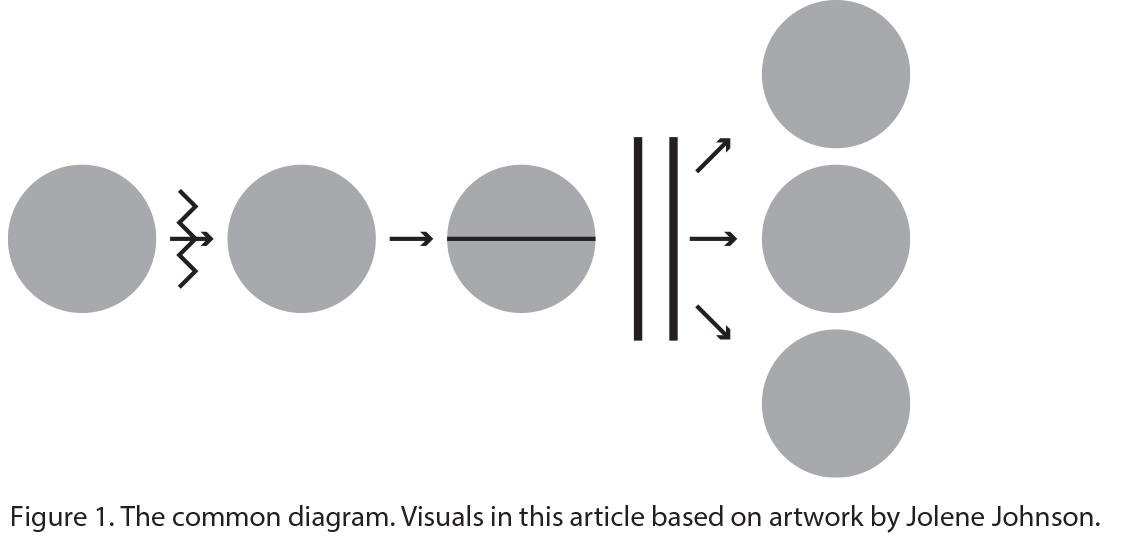
Diagrams such as this are visual representations of certain aspects of that all-encompassing plan. Our Heavenly Father's plan includes our eternal by, our present life, and our eternal futurity. It is impossible to correspond all aspects of that plan in i diagram. Neal A. Maxwell expressed: "Conversationally, we reference this nifty blueprint almost too casually at times; we even sketch its rude outlines on chalkboards and paper equally if information technology were the floor plan for an addition to one'due south house. Still, when we actually accept time to ponder the Plan, it is breathtaking and overpowering! Indeed, I, for i, cannot decide which creates in me the most awe—its very vastness or its intricate, individualized detail."[1]
We could never capture such vastness and particular in a single diagram or model. Nevertheless, models and visuals can enable us to meliorate grasp and teach key portions of this breathtaking plan.
In the Church, we have a proclivity for visual methods of learning and instruction the plan. The most common diagrams used are variations of figure i.[ii] This diagram utilizes various circles to portray where we were, where nosotros are, where we will go after death, and where we will end up eternally. This common diagram likewise uses lines to represent the major events in our progression through the plan: nascency and the veil, death, Resurrection, and Final Judgment. This basic configuration allows us to requite a brief nevertheless powerful overview of our eternal journey.
In spite of their introductory strengths, many ofttimes-used diagrams like figure 1 lack overt representation of many critical doctrines frequently discussed in the scriptures associated with the plan. It is possible, for case, to teach the plan as depicted in figure 1 without ever mentioning the mission or role of Jesus Christ, the Creation, the Autumn, spiritual expiry, Christ's Amende, or the principles and ordinances of his gospel. To perpetually teach the program with such omissions can lead people to focus solely on that which is overtly portrayed in the diagram.
To assist us anchor the many fundamental aspects of the program in our instruction, President Benson counseled us to employ "the letters and the method of instruction found in the [scriptures] to teach this great plan of the Eternal God."[3] Because people tend to learn, teach, and think the programme of redemption visually, there is a need for wide-ranging models that convey various aspects of the plan of redemption using principles and patterns used in the scriptures.
This article introduces one additional way of looking at the plan from a different "camera angle" than those presented in the past. We hope this perspective is helpful to students and teachers who may wish for a model that depicts multiple oftentimes-neglected core doctrines and centers around Jesus Christ and his Atonement. We intend for this diagram to supplement and enhance—rather than replace—currently used models.
The model outlined in this commodity visually portrays two concepts: a) the foundational doctrines of the program and b) the states of being through which humankind must pass in order to go more Christlike and return to alive forever with our heavenly parents.
Step ane: Premortal State
This leads to some central questions: What is the purpose of Heavenly Father'southward programme? Did God requite us his programme to assistance usa go somewhere or to assist united states of america go something? Our heavenly parents[4] intend for their children to "obtain a concrete body and gain earthly experience to progress toward perfection and ultimately realize their divine destiny as heirs of eternal life."[five] The divine destiny of God's children includes living with our heavenly parents. Nonetheless, equally important as it volition be to render to the presence of God, is that the ultimate aim of the plan?
If returning to God were the ultimate purpose of the plan, and then why did he ship us to earth in the beginning place? We were already in heaven, living with our heavenly parents as their spirit children. Only beingness in their presence was apparently non ultimate happiness for united states of america; nor was it the end of our progression. We are here on earth for a greater purpose. Our heavenly parents are perfect in every style and accept glorified, resurrected bodies. We seek to be similar them! Joseph Smith said, "If y'all wish to get where God is, you must be like God or possess the principles which God possesses."[6] What we get, therefore, determines our eternal destination, and the plan of happiness is God's design to enable that development.
To illustrate this concept visually, we begin with a dotted line. We are on that line if we are either similar God or in his presence.

The arrows on both sides of the dotted line represent the eternal past, or the premortal state of man, also as the eternal future, the final state of humankind, which we will elaborate on later in this article. Based on teachings from Abraham 3, nosotros began on the left side of the dotted line as intelligences[7] who were spiritually built-in into heaven as sons and daughters of heavenly parents. We shaded in the left end of the dotted line to illustrate being in God'southward presence.
In the premortal realm, major conditions differentiated us from our heavenly parents. They had perfected bodies of flesh and bone (D&C 130:22). We had spirit bodies that lacked vital physical capacities that enable eternal happiness. We as well lacked an infinite level of knowledge, ability, love, and experience that they possess. In improver, our heavenly parents enjoy eternal life. We could not progress to the measure and will of our Heavenly Begetter while in his presence in our spirit-body state. We had to go out and experience bloodshed in a fallen land.
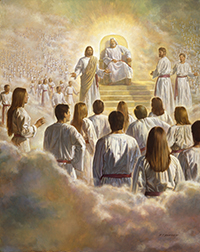 In the premortal realm, we had spirit bodies that lacked vital concrete capacities. We also lacked an space level of knowledge, ability, love, and experience.
In the premortal realm, we had spirit bodies that lacked vital concrete capacities. We also lacked an space level of knowledge, ability, love, and experience.
The Three Pillars of Eternity
Co-ordinate to his program, God would found 3 critical conditions to enable his children to abound toward becoming more than like him. Commencement, we had to accept a place where we could experience mortality's tests while separated from his presence. That would require the cosmos[8] of an world. Second, God's pure creation would need, through a procedure of bureau[nine], to enter a fallen state, thus assuasive for an opposition in all things (run into two Nephi 2:11). All things would otherwise have "remained in a land of innocence, having no joy, for they knew no misery; doing no proficient, for they knew no sin" (2 Nephi ii:23). Third, that fallen state would accept persisted and "the first judgment which came upon human being must needs have remained to an endless elapsing" except there "should be an infinite atonement" (2 Nephi 9:7; emphasis added).[10]
These iii foundational events—the Creation, the Fall, and the Atonement—are called the iii pillars of eternity. Book of Mormon prophets repeatedly used these pillars to teach the program. Regarding their human relationship, Elder Russell One thousand. Nelson stated, "The Book of Mormon reveals the of import interrelationships between the Cosmos, the Fall, and the Atonement. Ane cannot fully comprehend the Atonement without first understanding the Autumn; and the fall of Adam cannot exist fully understood without commencement understanding the Creation. These three slap-up doctrinal pillars sustain each other in God'south eternal plan."[11]
In the premortal world, earlier proceeding with the Cosmos, it was requisite that one exist establish who was both willing and able to perform the Atonement. This intercessor would mediate with eternal justice for our weaknesses, imperfections, and mortal condition and conquer both death and hell. These ii obstacles could not be defeated for us in heaven by the premortal spirit known as Jehovah; they could only be overcome past the uniquely qualified Jesus Christ in the flesh. Due to the Savior's distinctive nascency, he had the power to descend into both expiry and hell and burst their bands from within. He could and then ascend again to sky with infinite power to "describe all men unto"[12] him through the power of the Resurrection. Abraham recorded Heavenly Male parent's profound premortal question as follows: "Whom shall I send?" Due to the fact that Jesus was the Father'southward "Honey and Chosen from the outset" (Moses 4:2), it is probable that every middle in the heavenly throng turned and looked at the Lamb of God (Revelation v:6–7) to see his response to that question. The great premortal Messiah, he who was chosen from the beginning, simply stated, "Here am I, send me" (Abraham 3:27). Elderberry Neal A. Maxwell said, "Never has 1 individual offered, in then few words, to do so much for so many."[xiii]
Find how these 3 pillars form the ground for all other aspects of the program in the diagram below.
 Figure 3. The three pillars of eternity.
Figure 3. The three pillars of eternity.
Nosotros place Jesus Christ and his Atonement prominently in the centre of the diagram to illustrate his central role in the plan of redemption. The Prophet Joseph Smith taught that "the fundamental principles of our religion is the testimony of the apostles and prophets apropos Jesus Christ, 'that he died, was buried, and rose once again the third day, and ascended up into heaven'; and all other things, are only appendages to these, which pertain to our religion."[14] As Elder Bruce R. McConkie further stated, "We view the atonement of the Lord Jesus Christ as the center and core and middle of revealed religion."[xv]
The measure of cosmos for God's children in mortality is to become like their Heavenly Father. The land of being in which we dwell governs our chapters to progress. The pillars of eternity direct alter the various states of humankind. By establishing these three pillars, God gave us the opportunity to continue through further states of being in our quest for eternal progression. Volume of Mormon prophets used the word state over fifty times in specific reference to our progression through the program of conservancy. Those same prophets too teach nearly the relationship between the three pillars and the states through which humankind progresses.
Footstep 2: A Land of Innocence
When God created Adam and Eve in the Garden of Eden, they were created in a "land of innocence" (two Nephi 2:23) as immortal beings. They walked and talked with God and enjoyed his presence—hence, we solidly fill in the line between the Creation and the Fall. In this paradisiacal state, Adam and Eve did not know good or evil, joy or misery, happiness or sorrow. They were non capable of bearing children (run into 2 Nephi 2:22–23).
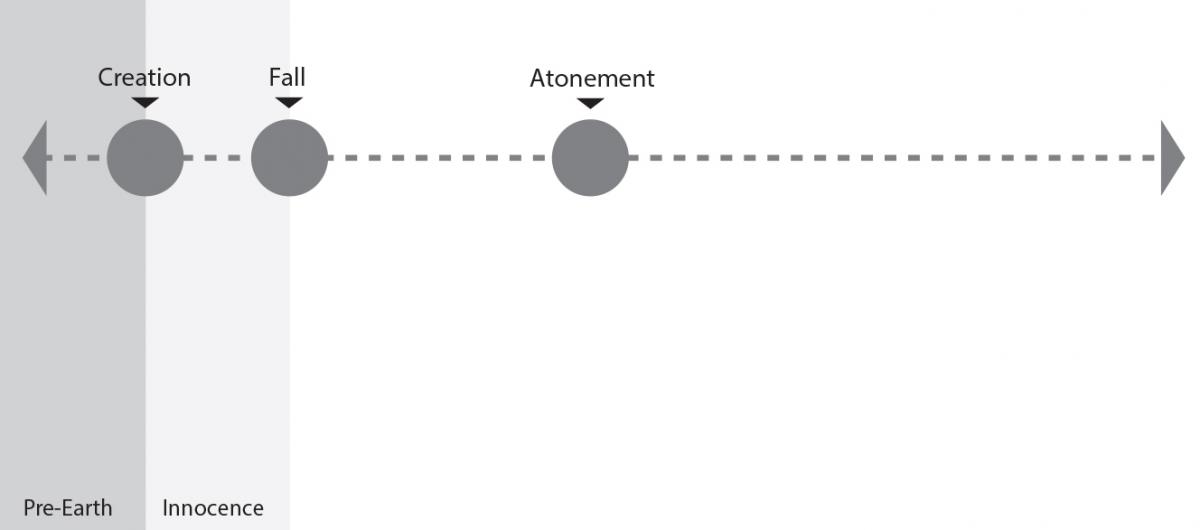 Figure 4. The state of innocence in Eden.
Figure 4. The state of innocence in Eden.
God did not intend for Adam and Eve to remain in a state of innocence forever. Had they remained in a state of Edenic innocence, they could not accept progressed toward godliness. They needed to experience a mortal, fallen state. The Fall and the resulting opposition in a mortal state initiated the optimal weather condition in which progression could occur.
Through the power of the Atonement, God graciously covers the commencement viii years of our life with innocence (see D&C 68:27 and Moroni 8:8–13). Thus, each of us personally passes through similar progressions equally Adam and Eve. This childhood state of innocence creates a safe environment for u.s. to begin learning how to navigate various choices in a mortal body without take a chance of eternal penalty for wrongdoing.
Step 3: A Fallen, Mortal State
The Fall ushered in a mortal land and introduced 2 major consequences for Adam, Eve, and all their subsequent posterity: physical death and spiritual decease. In a gospel sense, death means separation (of two things). Physical death is the separation of the spirit and body. Spiritual decease represents our separation from God.
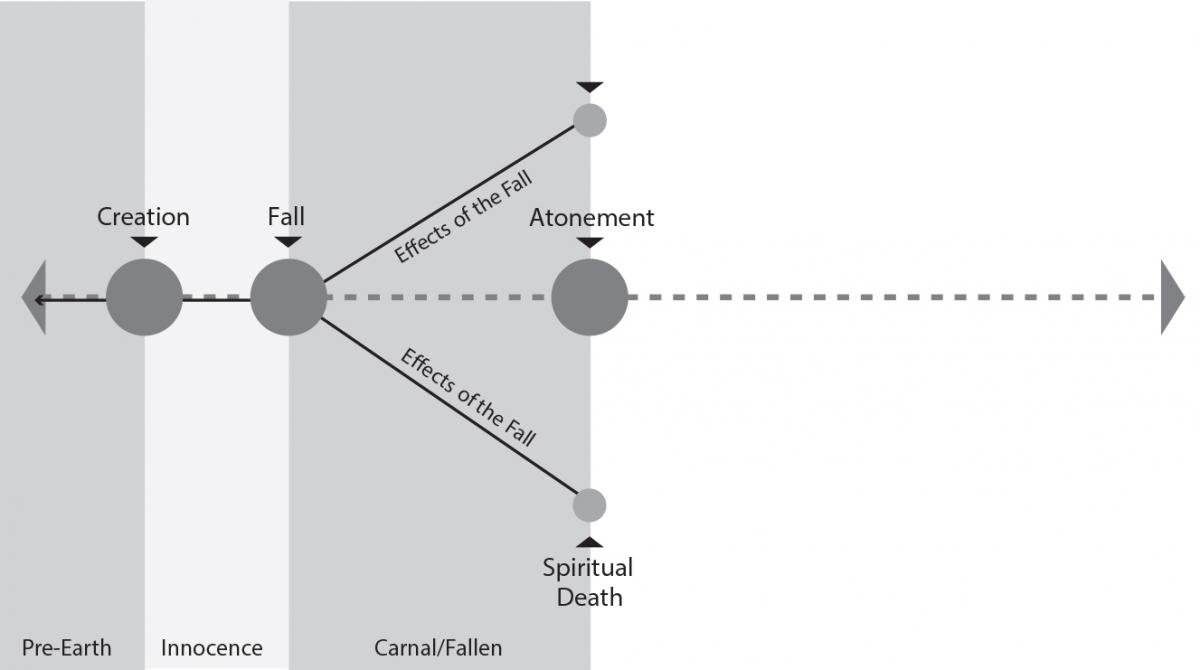 Figure 5. The two deaths.
Figure 5. The two deaths.
The fallen condition of spiritual expiry, or separation from God, provides the situation and weather condition that enable all of God'southward children to be tested, learn from their own experience, and further develop the attributes of God. From birth to decease, our fallen state hosts a battle, constantly played out, between our spirit (arriving to world from the presence of God) and our torso (fashioned from fallen affair). Though this body is a sacred gift, information technology has desires, appetites, and passions that, when left unchecked, requite Satan power to bind and captivate God'southward children (2 Nephi 2:29).
Stated simply, the body in a natural, carnal, fallen country seeks ease and pleasure for itself. Pleasure for the body comes in the gratification of natural appetites and passions. When our spirit fails to "bridle all [our] passions" (Alma 38:12) according to the commandments, the body'due south increasingly fed appetites and passions tend to grow and subsequently pb to bondage and spiritual regression. This idea was further expressed by Elderberry David A. Bednar:
As sons and daughters of God, nosotros take inherited divine capacities from Him. But we presently alive in a fallen world. The very elements out of which our bodies were created are by nature fallen and always subject to the pull of sin, corruption, and decease. Consequently, the Fall of Adam and its spiritual and temporal consequences touch u.s.a. most directly through our physical bodies. And however we are dual beings, for our spirit that is the eternal part of united states is tabernacled in a physical torso that is subject to the Fall. As Jesus emphasized to the Apostle Peter, "The spirit indeed is willing, only the mankind is weak" (Matthew 26:41).
The precise nature of the test of mortality, then, can exist summarized in the following question: Volition I respond to the inclinations of the natural man, or will I yield to the enticings of the Holy Spirit and put off the natural human being and become a saint through the Atonement of Christ the Lord (see Mosiah 3:19)? That is the test. Every appetite, desire, propensity, and impulse of the natural man may exist overcome by and through the Atonement of Jesus Christ. We are here on the earth to develop godlike qualities and to determent all of the passions of the mankind.[16]
If we came to earth for the opportunity to become more similar God, why would he place us in fallen bodies of flesh that have a will toward evil?[17] Why place us in bodies that, by nature, seek to pull us increasingly abroad from his attributes and presence? The opposition of a mortal body provides a very real test and gives us the opportunity to "[put] off the natural man and [become] a saint through the atonement of Christ the Lord" (Mosiah 3:19). Much similar the strengthening effect on muscles provided by the resistance of weights, equally we overcome the natural homo and obey God's commandments, we overcome the resistance of our fallen, carnal state and become more like God.
The scriptures comprise many stories of people who overcame intense opposition while accomplishing marvelous works. For mortality to be a valid trial of faith and examination of our reliance on the Lord, the opposition must be "in" u.s., rather than purely "against" us. Just and then can we realize that we cannot prevail on our own. Our fallen condition and lecherous nature constantly remind us of our absolute, ongoing, spread-out need for a Savior and his Atonement. Adam and Eve's Fall initiates our dire need for redemption that only the Atonement can bring.
Step 4: A State of Redemption
Christ has power to redeem humankind from two things: the direct effects of the Autumn and our own sins.
Through the Resurrection,[18] Christ redeems all humankind unconditionally from the Fall. Without an infinite Atonement, nosotros would forever remain in our fallen state, spiritually expressionless, shut out from the presence of God. The prophet Jacob used the same four-word phrase "to rising no more" (two Nephi nine:7–8) to describe what would happen to both our bodies and our spirits if the Savior had not completed an infinite Atonement for us. He further states that nosotros would become field of study to the devil and go like him. Were this and then, the visual portrayals of physical and spiritual decease in figure 5 would be arrows, demonstrating the eternal, ongoing, and infinite consequences.
Jesus completed the infinite Atonement with his Resurrection and fabricated it possible to redeem all of u.s. from both consequences: death and hell. Many sympathise that resurrection overcomes physical expiry. Unfortunately, many distort the atmospheric condition of redemption from spiritual decease, or separation from God's presence, which we besides inherited from Adam and Eve. This inherited spiritual death is very dissimilar from the separation caused past our own misuse of agency. As demonstrated below, the Book of Mormon repeatedly teaches that the Resurrection of Jesus Christ unconditionally redeems all of God's children from not but their concrete death, but as well their inherited spiritual decease (see Mormon nine:13).
From atop the walls of Zarahemla, Samuel the Lamanite taught, "For behold, he surely must die that salvation may come; yea, it behooveth him and becometh expedient that he dieth, to bring to pass the resurrection of the expressionless, that thereby men may be brought into the presence of the Lord" (Helaman 14:15). He makes the indicate stronger in the side by side verse: "Yea, behold, this death bringeth to pass the resurrection, and redeemeth all mankind from the first decease—that spiritual death" (v. 16; accent added). To make the point unmistakable, he restated it in the next poesy, "But behold, the resurrection of Christ redeemeth mankind, yea, even all mankind, and bringeth them back into the presence of the Lord" (5. 17). Samuel left no question about the universality of redemption from our separation from God'southward presence through the Resurrection of Christ.
Samuel was not the just prophet who taught of the universality of redemption. Moroni stated, "And because of the redemption of human being, which came past Jesus Christ, they are brought back into the presence of the Lord; yea, this is wherein all men are redeemed, considering the death of Christ bringeth to laissez passer the resurrection, . . . and they shall come forth, both small and great, and all shall stand before his bar, being redeemed and loosed from this eternal ring of death" (Mormon 9:13). Amulek told the people of Ammonihah, "Now, this restoration shall come to all . . . [and everyone, in a resurrected trunk,] shall exist brought and exist arraigned before the bar of Christ the Son, and God the Begetter, and the Holy Spirit, which is one Eternal God, to exist judged according to their works, whether they be skillful or whether they be evil" (Alma eleven:44). In Book of Mormon terminology, we might say that we are redeemed from Adam'south two deaths past grace alone (see 2 Nephi 9:22; Alma 42:23; Mormon 7:6) so we tin can and so exist perfectly judged of our own works (see ii Nephi 9:15; 28:23; Alma 12:viii).
Because of this redemption, not one of God'south children born into this mortal, fallen state will be punished for Adam'southward transgression (come across 2d article of religion ). In other words, "The way is prepared from the fall of man, and conservancy is free" (2 Nephi 2:4).
Elder D. Todd Christofferson also taught this doctrine when he said the post-obit:
The Savior's Redemption has two parts. First, it atones for Adam's transgression and the consequent Fall of human by overcoming what could exist called the straight effects of the Fall—physical death and spiritual expiry. Physical death is well understood; spiritual death is the separation of man from God. In the words of Paul, "For equally in Adam all die, nonetheless in Christ shall all be made alive" (ane Corinthians 15:22). This redemption from physical and spiritual expiry is both universal and without condition.[19]
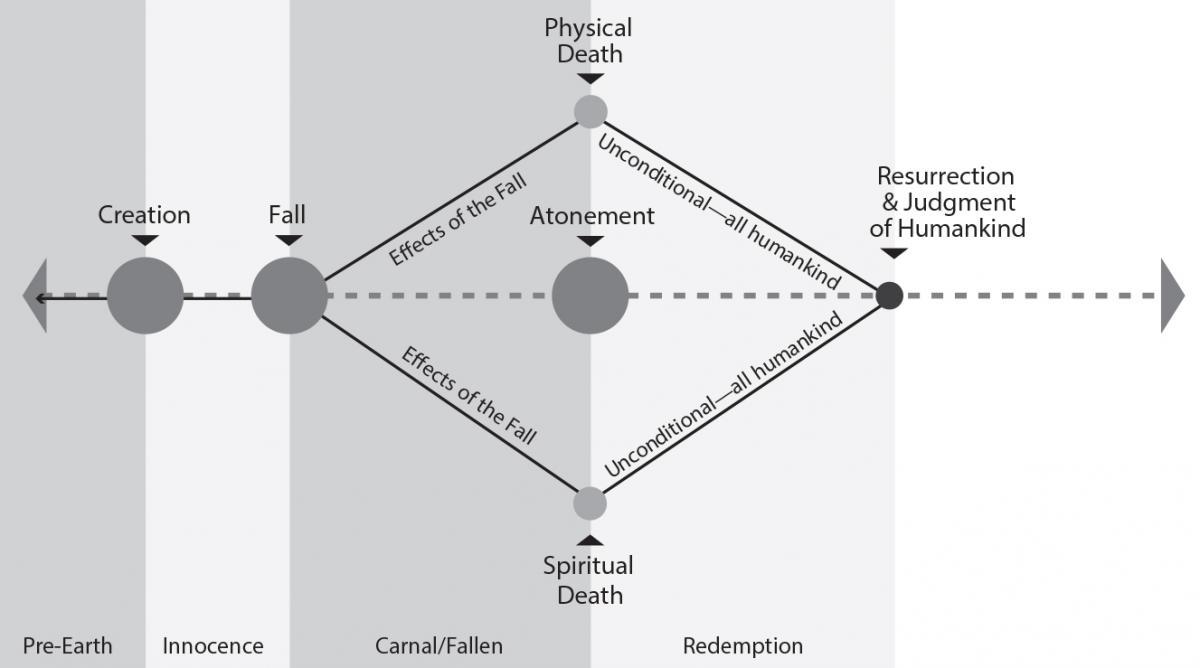 Effigy six. Universal redemption from two deaths.
Effigy six. Universal redemption from two deaths.
Why would God want to bring everyone, the evil every bit well as the righteous, back into his presence? The Book of Mormon prophets are consistent on this point. The doctrine of the Resurrection is inseparably continued with the doctrine of the Judgment.[twenty] The Amende brings to laissez passer the Resurrection, and the Resurrection brings all humankind back into the presence of God to be judged (meet Alma 42:23; Helaman 14:15–17; 2 Nephi 9:xv, 21–22; Mormon 9:12–14).
Everyone will stand earlier the Godhead (see Alma 11:44) having been redeemed from all the direct effects of the Autumn "through the merits, and mercy, and grace" of Christ alone (2 Nephi two:viii). He paid a price to the Begetter that we could not pay for ourselves (run across Alma 42:11–16). In that moment, each kid of God volition stand up liberated from all burdens inflicted by others' choices. That land of redemption from all external consequences will permit Jesus to perfectly judge us based on our own use of bureau.
Conditional Salvation from Sin
Through birth, all inherit the effects of the Fall and enter into a fallen state. Being separated from God, all but Jesus commit sin once they reach the historic period of accountability (see Alma 42:14; D&C 68:27). At the Judgment, all must account for those sins.
Although redemption from the Fall is unconditional for all, salvation from our ain sins is granted merely on the "conditions of repentance" (D&C 138:nineteen; Alma 42:xiii; Helaman 5:eleven). Samuel taught the Nephites that Christ "bringeth to pass the condition of repentance, that whosoever repenteth the aforementioned is non hewn down and cast into the burn down; only whosoever repenteth not is hewn down and cast into the fire" (Helaman 14:18). The weather of repentance are ane of the great themes of the Volume of Mormon. Often referred to as the "doctrine of Christ" (2 Nephi 31:two, 21; 32:half dozen; 3 Nephi xi:31–41), the weather condition of repentance also form a major role of the gospel of Jesus Christ equally he himself divers it in three Nephi 27:thirteen–21.
Elder D. Todd Christofferson further taught:
The second aspect of the Savior'due south Atonement is redemption from what might be termed the indirect consequences of the Fall—our own sins as opposed to Adam's transgression. . . . Considering we are answerable and we make the choices, the redemption from our own sins is conditional—conditioned on confessing and abandoning sin and turning to a godly life, or in other words, conditioned on repentance (run into D&C 58:43).[21]
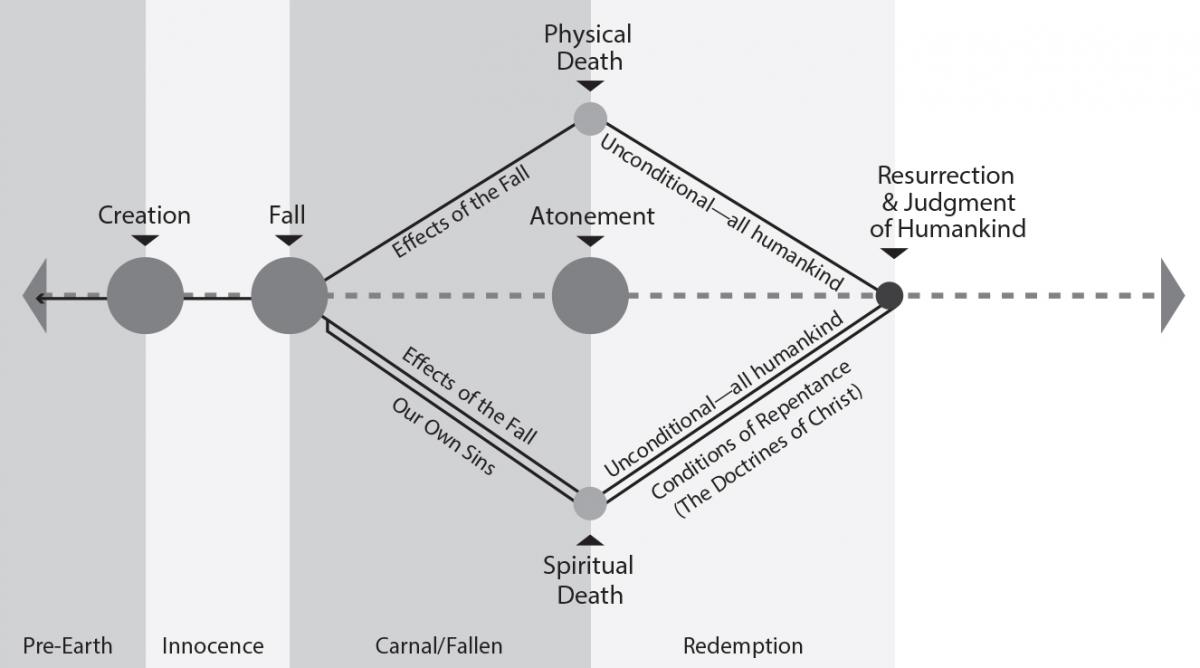 Figure 7. Redemption from our own sins
Figure 7. Redemption from our own sins
Meeting the conditions of repentance constitutes "all nosotros can do" (two Nephi 25:23, Alma 24:11), reconciles united states of america to God, and opens to usa the fountains of redeeming grace. Ultimately, redemption from our own sins involves making and keeping sacred covenants and receiving grace.[22]
It is important to realize that our efforts to live the gospel are necessary but non sufficient for eternal salvation. The police force cannot save us; it can only condemn (come across ii Nephi ii:five). Jesus Christ saves us through his grace.[23] The Book of Mormon teaches a clear human relationship between what we exercise and what consequence it has on our standing with God: "Now they did not suppose that conservancy came by the law of Moses [or any other constabulary]; merely the law of Moses did serve to strengthen their organized religion in Christ; and thus they did retain a hope through religion, unto eternal conservancy" (Alma 25:sixteen). Thus our efforts to live the gospel of Jesus Christ practice not save usa; they increase our faith in Christ. Increasingly, we trust him and seek his will rather than our own. That process, fueled past his mercy and grace, changes u.s.a.. We become more and more like him, and less like the natural and fallen man, who seeks only to gratify mortal desires, appetites, and passions.
Step 6: The Final State of Man
Many elements of the plan of redemption culminate at the judgment bar of God. The Judgment ushers in the concluding state of humankind. An angel instructed Rex Benjamin to teach that Jesus Christ did what he did and suffered what he suffered "that a righteous judgment might come upon the children of men" (Mosiah 3:10). Through the Atonement of Jesus Christ, all will be redeemed from the grave and brought back into the presence of God, but that redemptive reunion, for some, will be both painful and temporary. President Ezra Taft Benson said, "Zero is going to startle us more than when we laissez passer through the veil to the other side than to realize how well we know our Male parent and how familiar His face is to us."[24]
Multiple Volume of Mormon prophets addressed the judgment bar response of those who fail to meet the Savior's conditions of repentance. King Benjamin declared, "Therefore if that homo repenteth not, and remaineth and dieth an enemy to God, the demands of divine justice do awaken his immortal soul to a lively sense of his ain guilt, which doth cause him to shrink from the presence of the Lord, and doth fill his breast with guilt, and pain, and anguish, which is like an unquenchable fire, whose flame ascendeth up forever and ever" (Mosiah 2:38; see too 3:24–25; Helaman 14:18; Moroni 9:4).
Alma the Younger too used vivid imagery to describe that event for the unrepentant: "If we have hardened our hearts against the word, insomuch that it has not been found in us, so volition our state be awful, for so we shall be condemned. . . . And in this awful state nosotros shall not dare to look upwardly to our God; and we would fain be glad if we could command the rocks and the mountains to fall upon usa to hide u.s. from his presence (Alma 12:13–14; encounter also Mosiah 16:five).
With additional revelation and clarification received through the Prophet Joseph Smith, we learn that Jesus Christ "glorifies the Father, and saves all the works of his hands, except those sons of perdition who deny the Son after the Begetter has revealed him" (D&C 76:43). Excepting the sons of perdition, all humankind will exist "saved" into one of three degrees of glory: celestial, terrestrial, or telestial. Elder Dallin H. Oaks taught, "These 3 different degrees of celebrity have a special relationship to the three unlike members of the Godhead."[25]
Those who enter the celestial kingdom dwell eternally in a state of never-ending happiness (see D&C 121:45; Mosiah 2:41). In his final message, Mormon wrote, "And [Jesus] hath brought to pass the redemption of the earth, whereby he that is found guiltless before him at the judgment 24-hour interval hath it given unto him to dwell in the presence of God in his kingdom" (Mormon 7:7). Those in the celestial kingdom "shall dwell in the presence of God and his Christ forever and ever" (D&C 76:62).
Those in the terrestrial kingdom "receive of the presence of the Son, only not of the fullness of the Father" (5. 77). Those who receive a telestial celebrity "are bandage downwards to hell and suffer the wrath of Almighty God, until the fullness of times. . . . But where God and Christ dwell they cannot come, worlds without end" (vs. 106, 112). They will receive "not of his fullness in the eternal earth, just of the Holy Spirit through the ministration of the terrestrial" (v. 86).
Those who deny the Holy Ghost cannot acquit a telestial glory. These sons of perdition volition shrink from the presence of God to outer darkness as the merely ones "on whom the second death shall have any power" (D&C 76:37; see also Alma 12:16).
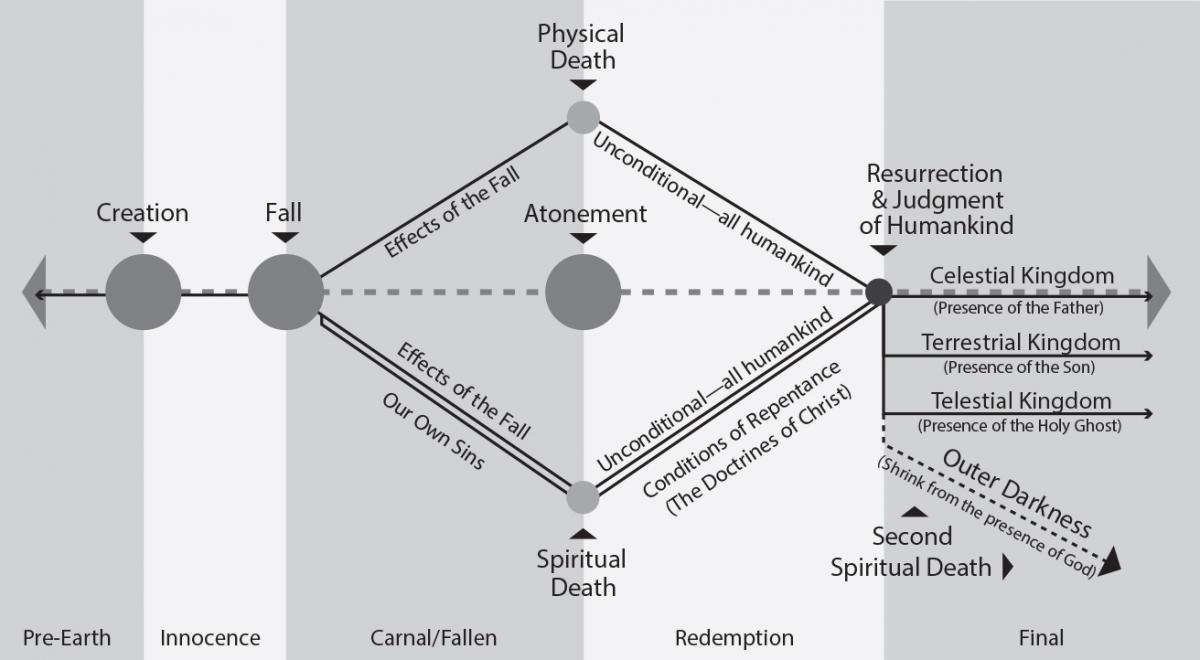 Figure 8. The plan of redemption.
Figure 8. The plan of redemption.
At our Judgment, nosotros will have a "perfect knowledge like unto [those] in the flesh, save it exist that our knowledge shall be perfect" (2 Nephi nine:13). This perfect cognition will kindle a "bright recollection of all our guilt" (Alma 11:43). In this awareness, even the hardest of hearts volition admit that "all his judgments are just; that he is but in all his works" (Alma 12:15). God's programme is then fair that even telestial-bound souls will "bow the human knee, and . . . confess to him who sits upon the throne forever and always" (D&C 76:110) that his glorious programme is perfectly fair.[26]
It would be neither just nor merciful for God to strength the wicked into the celestial kingdom. Could such a person feel any peace or contentment in God's kingdom, surrounded past his perfection and glory? Moroni teaches that the wicked would be more "miserable to dwell with a holy and just God, nether a consciousness of [their] filthiness before him, than [they] would to dwell with the damned souls in hell" (Mormon 9:4). Hence, God'southward training of multiple glories shows his love for his children and the role of agency throughout the entire program—culminating in the perfect balance of justice and mercy in their eternal judgment.
Those who repent of all their sins will receive "all that [the] Father hath" (D&C 84:38). For those who cull something less, they will "enjoy that which they are willing to receive, considering they were not willing to enjoy that which they might have received" (D&C 88:32). Equally C. S. Lewis wrote, "There are only 2 kinds of people in the end: those who say to God, 'Thy will be done,' and those to whom God says, in the end, 'Thy volition be done.' All that are in Hell, choose information technology. Without that self-choice there could be no Hell. No soul that seriously and constantly desires joy volition ever miss it. Those who seek notice. To those who knock information technology is opened."[27]
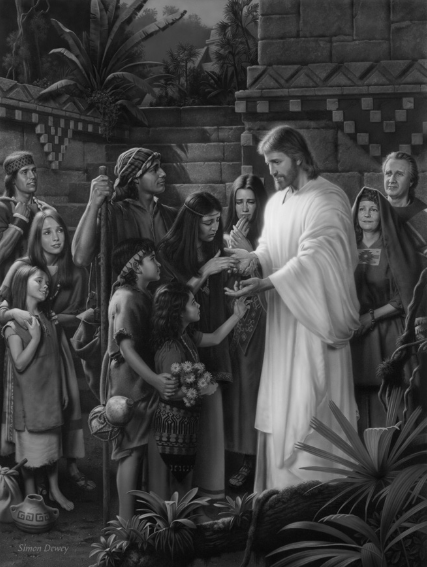 The Resurrection of Jesus Christ unconditionally redeems all of God's children from not only their physical death, merely also their inherited spiritual expiry.
The Resurrection of Jesus Christ unconditionally redeems all of God's children from not only their physical death, merely also their inherited spiritual expiry.
Conclusion
Traditional location-focused models of the plan of salvation provide a wonderful introduction and overview of our journey through the eternities. The model presented here complements these widely used diagrams by focusing on the three pillars that uphold that plan and highlight the axis of the Savior Jesus Christ and his infinite Atonement. Additionally, this model emphasizes the diverse states of being through which we laissez passer in our journey through the plan. It also emphasizes other major roles of Jesus Christ equally Creator and Guess within the Father's plan.
Through the Savior'due south perfect and space Atonement, God has enabled all of united states of america to overcome all furnishings of the Autumn and progress to become more like him. Anybody always built-in into bloodshed will receive unconditional redemption from the directly effects of the fall through the Resurrection of Christ. That universal redemption will atomic number 82 all to exist judged on their utilize of agency, based on their own accountability. Eternal conservancy from the indirect effects of the Autumn (our own sins) is granted to those who see the Savior's conditions for repentance (Alma 42:27).
These doctrines (Resurrection and Judgment), taught with the pillars of eternity, have supernal power to stir God's children to repentance. Hence, Joseph Smith taught, "The doctrine of the Resurrection of the Dead and Eternal Judgment are necessary to preach among the first principles of the Gospel of Jesus Christ."[28]
Many prophets in the Book of Mormon follow a powerful instruction design. They conspicuously explicate certain elements of the plan of conservancy and then invite their audiences to act on what they taught. Those invitations often include things such every bit increasing one's faith in Christ, repenting of sins, existence baptized, or continuing to press forward in the path that leads to eternal life (see Alma 7:14; 34:31; Helaman 7:23; 10:fourteen; 12:23; 14:19; 3 Nephi nine:22; Mormon v:24; 7:8; Ether 4:18).
After dying on the cross, Jesus taught the spirits in paradise based on this same pattern. "And there he preached to them the everlasting gospel, the doctrine of the resurrection and the redemption of flesh from the fall, and from individual sins on atmospheric condition of repentance" (D&C 138:nineteen).
Studying multiple aspects of God'due south plan through more than ane lens allows us to see more than facets of what he has put into place for our eternal progression and happiness. This opens additional channels for the Holy Ghost to inspire increased faith in the Savior, repentance of our sins, and increased desires to brand and keep covenants with God.
When nosotros study and teach his programme using the words and examples that he and his prophets use, we will have a greater tendency to inspire more than of his children to repent and fix to stand before him spotless at the peachy and last mean solar day—having been reconciled to God through his Only Begotten Son (see ii Nephi 10:24; 25:23; Jacob 4:11).
Notes
---
[1] Neal A. Maxwell, "Thanks Be to God," Ensign July 1982, 51.
[2] This can exist illustrated by a elementary Internet search on the key phrase "plan of salvation." Narrowing the search to include only images reveals the dominance of the traditional circles and lines in plan visualizations. This can also be seen every bit the starting time selection for teaching the programme in the Book of Mormon Instructor Resource Transmission, found at https://
[3] Ezra Taft Benson, "The Book of Mormon and the Doctrine and Covenants," Ensign, May 1987, 83.
[4] For reference to our Mother in Heaven, come across "Female parent in Heaven," The Church of Jesus Christ of Latter-day Saints, https://
[five] "The Family: A Proclamation to the Globe," Ensign, November 2010, 129.
[6] History, 1838–1856, volume C-one Addenda, 62, http://
[7] Meet specifically verses 18–28. Meet as well the lds.org Guide to the Scriptures entry for "Intelligence, Intelligences" and the Encyclopedia of Mormonism entry on "Intelligences."
[eight] "Creation," The Church of Jesus Christ of Latter-twenty-four hour period Saints, https://
[9] "Fall of Adam," The Church of Jesus Christ of Latter-day Saints, https://
[x] "Atonement of Jesus Christ," The Church building of Jesus Christ of Latter-day Saints, https://
[11] Russell M. Nelson, "A Treasured Testament," Ensign, July 1993, 64. Elder Bruce R. McConkie also stated something similar: "These iii divine events—the three pillars of eternity—are inseparably woven together into one grand tapestry known as the eternal plan of salvation. A New Witness for the Articles of Faith (Table salt Lake Urban center: Deseret Volume, 1985), 81.
[12] Run into 2 Nephi 26:24 and iii Nephi 27:fourteen–fifteen.
[13] Neal A. Maxwell, "Meekness—A Dimension of True Discipleship," Ensign, March 1983, 71.
[xiv] History, 1838–1856, volume B-1, 795-96, http://
[15] Bruce R. McConkie, A New Witness for the Articles of Faith (Common salt Lake City: Deseret Book, 1985), 81.
[16] David A. Bednar, "Nosotros Believe in Being Chaste," Ensign, May 2013, 42–43.
[17] See two Nephi 2:29.
[xviii] The LDS essay "Resurrection," The Church of Jesus Christ of Latter-twenty-four hour period Saints, https://
[19] D. Todd Christofferson, "Redemption," Ensign, May 2013, 109.
[xx] See Terry B. Ball, "The Last Judgment," in The Book of Mormon and the Bulletin of the Iv Gospels, ed. Ray L. Huntington and Terry B. Ball (Provo, UT: Religious Studies Middle, 2001), 1–18.
[21] Christofferson, "Redemption," Ensign, May 2013, 109–10.
[22] Preach My Gospel: A Guide to Missionary Service (Salt Lake City: The Church of Jesus Christ of Latter-day Saints, 2004), 60–lxx. Run into likewise Robert L. Millet, Past Grace Are Nosotros Saved (Common salt Lake Metropolis: Bookcraft, 1989). Run into also Bruce C. Hafen, "Grace," in Encyclopedia of Mormonism, ed. Daniel H. Ludlow (New York: Macmillan, 1992), two:560–63.
[23] See 2 Nephi ii:6–ten; Romans iii:24, 28. Notation that Joseph Smith's change in poetry 24 is substantively the same as Martin Luther's critical change in his German language Bible that could be argued as the formation of the Protestant Reformation. Martin Luther added the word Allein (which means alone) afterward the word religion. Joseph added the word only afterwards the word justified.
[24] Ezra Taft Benson, "Jesus Christ—Gifts and Expectations," Speeches of the Year, 1974 (Provo, UT: Brigham Young University Press, 1975), 313.
[25] Dallin H. Oaks, "Betrayment and Restoration," Ensign, May 1995, 86.
[26] This is a powerful reference to a prophecy from Isaiah 45:22–23, where Jehovah declared that "every human knee shall bow, every tongue shall swear." Paul, in ii of his letters, referenced that statement, once in Romans 14:11 and and then more than direct in Philippians 2:eleven, where he stated "that every tongue should confess that Jesus Christ is Lord, to the celebrity of God the Father." In this item instance, Paul is equating Jesus Christ with Jehovah from the Isaiah passage. This Isaiahnic phrase is also used in Mosiah 27:31 and D&C 88:104.
[27] C. S. Lewis, The Great Divorce (New York: Macmillan, 1946), 72–73.
Source: https://rsc.byu.edu/vol-18-no-1-2017/great-plan-happiness-christ-centered-visual-approach

0 Response to "Families and the Great Plan of Happiness, Judd, Dorius, and Dollahite"
Post a Comment